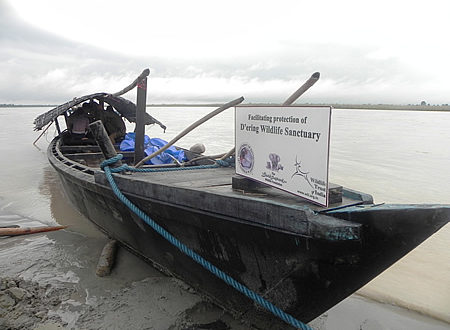The boat that rocked: Catching poachers in D’ering (AP)

WTI, supported by the David Shepherd WIldlife Foundation, handed over a ‘tuktuki’, as the boat is locally called, which has helped the forest department in numerous arrests and seizures.
Photo by: Sunil Kyarong/WTI
D’ering (Arunachal Pradesh), April 17, 2013: Once known to be a place where hunters gathered, D’ering Memorial Wildlife Sanctuary in northeast India has steadily seen its reputation change. And for the better.
Located in the heart of Arunachal Pradesh, the sanctuary is a large alluvial grassland supporting a wide range of fauna including the national animal – tiger, the national heritage animal – elephant, a large number of water buffalos and Sambar deer, endangered birds like the Bengal florican and great hornbill, and the national aquatic animal – the magnificent Gangetic dolphin. It is spread over an area of 190 sq km, and is bordered by two rivers – Siang and Sibia – which also criss-cross their way through it, forming many small river islands in between.
The rivers however represent a paradox in this paradise. While they ensure the sanctuary’s productivity, they also create a hindrance for foot patrolling by the Forest Department staff. As a result, the rich heritage of the sanctuary was constantly at threat.
“In the past, D’ering was referred to as a haven for hunters,” said Tashi Mize, Divisional Forest Officer, Pasighat, and administrative head of the sanctuary. “They were almost guaranteed to go home with some wild meat slung over their shoulders,” he added, talking of the richness of the area, as well as the free run that the hunters had due to limitations faced by the authorities.
In December 2011, soon after he took up office, Mize approached the Wildlife Trust of India (WTI) for assistance under its Rapid Action Projects (RAPs) to help improve accessibility. Supported by the David Shepherd Wildlife Foundation (DSWF), WTI provided a motorboat, as requested by the DFO.
“The tuktuki (as the boat is called there) has been a blessing,” said DFO Mize. “We were completely immobile before it came. Since the boat has been put to use, we have been able to arrest a number of hunters and have seized equipments used, including boats and trolleys used in communication and transport.”

The team holds up nets confiscated from poachers in the wildlife sanctuary
Recalling the first incident of arrest of a group of hunters, the DFO said, “The deputy ranger and a few forest guards spotted some hunters coming in from Assam through the water. They quietly got into the tuktuki and followed them. Finally, a chase began; we kept losing them initially because the rivers cross so intricately and the thickets are easy to hide in. Two hours later, our team managed to catch up with them.”
Another RAP was sanctioned by WTI with DSWF support in July last year. Ten men were recruited from fringe villages to assist the Forest Department in patrolling, for three months, during a traditional festival (Araan), when hunting is at its highest.
Maksam Tayeng, a journalist from Arunachal Pradesh, said, “I’ve been observing and writing about this area for the last few years. I can’t even begin to describe how much has changed since the boat arrived. There has been a paradigm shift in the way tribals and hunters have begun to view it. It was especially encouraging that, this year, not even one hunter or poacher was spotted in the sanctuary.”

Members of the local communities even handed over their weapons, saying they now have no use for them
In the coming year, DSWF and WTI will be providing 40 patrolling kits (including backpacks, winter jackets, rain suits, sleeping bags and caps) for the frontline staff of the Sanctuary.
“WTI has helped us every time we needed it, and now we can take pride in the kind of control we have over our sanctuary,” added Mize.
Sunil Kyarong, WTI’s regional head – northeast India, said, “There are around 4 villages around the eastern periphery of the sanctuary, and everyone there really appreciates how the boat has changed things in the forest. It has not only been beneficial in sighting poachers, but has also been used to rescue people during the annual floods. It even helps ferry people and has greatly improved communication across the banks. The department has also received a sanction for two more boats, thanks to the success of the first one.”
He added, “With increased activities by the forest department, the levels of awareness among tribals in the area have also steadily increased. So far, over 100 people have surrendered their airguns, including two hunters who handed in their double-barrel guns and said, “The licenses for these guns were given because they were meant to protect our lives. There is no threat to our lives anymore, and we feel that we shouldn’t threaten the existence of any animals’ lives either.”
This article was also published in DSWF’s quarterly magazine, and can be read here.









